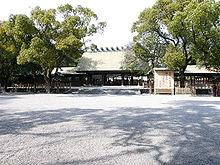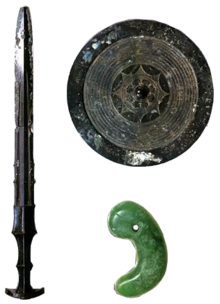- Kusanagi
-
For other uses, see Kusanagi (disambiguation).
Part of the series on
Japanese mythology
Religions · Divinities Texts and Myths Kojiki · Nihon Shoki ·Kujiki Hotsuma Tsutae · Nihon Ryōiki Konjaku Monogatarishū Sacred Objects Amenonuhoko · Kusanagi Sesshō-seki · Tonbogiri Three Sacred Treasures Mythical Locations Ryūgū-jō · Yomi Takamagahara Japanese Mythology Kusanagi-no-Tsurugi (草薙の剣) is a legendary Japanese sword and one of three Imperial Regalia of Japan. It was originally called Ama-no-Murakumo-no-Tsurugi (天叢雲剣, "Sword of the Gathering Clouds of Heaven") but its name was later changed to the more popular Kusanagi-no-Tsurugi ("Grass Cutting Sword").
Contents
Legends
The history of the Kusanagi-no-Tsurugi extends into legend. According to Kojiki, the god Susanoo encountered a grieving family of kunitsukami ("gods of the land") headed by Ashinazuchi (足名椎) in Izumo province. When Susanoo inquired of Ashinazuchi, he told him that his family was being ravaged by the fearsome Yamata-no-Orochi, an eight-headed serpent of Koshi, who had consumed seven of the family's eight daughters and that the creature was coming for his final daughter, Kushinada-hime (奇稲田姫). Susanoo investigated the creature, and after an abortive encounter he returned with a plan to defeat it. In return, he asked for Kushinada-hime's hand in marriage, which was agreed. Transforming her temporarily into a comb (one interpreter reads this section as "using a comb he turns into [masquerades as] Kushinada-hime") to have her company during battle, he detailed his plan into steps.
He instructed the preparation of eight vats of sake (rice wine) to be put on individual platforms positioned behind a fence with eight gates. The monster took the bait and put one of its heads through each gate. With this distraction, Susanoo attacked and slew the beast (with his sword Worochi no Ara-masa[1]). He chopped off each head and then proceeded to the tails. In the fourth tail, he discovered a great sword inside the body of the serpent which he called Ame-no-Murakumo-no-Tsurugi, which he presented to the goddess Amaterasu to settle an old grievance.
Generations later, in the reign of the Twelfth Emperor, Keikō, Ame-no-Murakumo-no-Tsurugi was given to the great warrior, Yamato Takeru as part of a pair of gifts given by his aunt, Yamato-hime the Shrine Maiden of Ise Shrine, to protect her nephew in times of peril.
These gifts came in handy when Yamato Takeru was lured onto an open grassland during a hunting expedition by a treacherous warlord. The lord had fiery arrows fired to ignite the grass and trap Yamato Takeru in the field so that he would burn to death. He also killed the warrior's horse to prevent his escape. Desperately, Yamato Takeru used the Ame-no-Murakumo-no-Tsurugi to cut back the grass and remove fuel from the fire, but in doing so, he discovered that the sword enabled him to control the wind and cause it to move in the direction of his swing. Taking advantage of this magic, Yamato Takeru used his other gift, fire strikers, to enlarge the fire in the direction of the lord and his men, and he used the winds controlled by the sword to sweep the blaze toward them. In triumph, Yamato Takeru renamed the sword Kusanagi-no-Tsurugi (lit. "Grasscutter Sword") to commemorate his narrow escape and victory. Eventually, Yamato Takeru married and later fell in battle with a monster, after ignoring his wife's advice to take the sword with him.
History
Although the sword is mentioned in the Kojiki, this book is a collection of Japanese myths and is not considered a historical document. The first reliable historical mention of the sword is in the Nihonshoki.[2] Although the Nihonshoki also contains mythological stories that are not considered reliable history, it records some events that were contemporary or nearly contemporary to its writing, and these sections of the book are considered historical. In the Nihonshoki, the Kusanagi was removed from the Imperial palace in 688, and moved to Atsuta Shrine after the sword was blamed for causing Emperor Temmu to fall ill. Along with the jewel and the mirror, it is one of the three Imperial Regalia of Japan, the sword representing the virtue of valor.
Kusanagi is allegedly kept at Atsuta Shrine but is not available for public display, and its existence cannot be confirmed. During the Edo period, a Shinto priest[who?], claimed to have seen the sword. According to him, the sword was about 84 cm long, shaped like calamus, fashioned in a white metallic color, and well maintained. Another record claims that this priest died from the curse and the power of the sword, but this is most likely a story that was spread to emphasize its power.[citation needed] Recently[when?], Japan's nationally run broadcasting station, NHK, went to Atsuta Shrine to videotape the sword but were turned away.[citation needed]
In The Tale of the Heike, a collection of oral stories transcribed in 1371, the sword is lost at sea after the defeat of the Heike clan in the Battle of Dan-no-ura, a naval battle that ended in the defeat of the Heike clan forces and the child Emperor Antoku at the hands of Minamoto no Yoshitsune. In the tale, upon hearing of the Navy's defeat, the Emperor's grandmother led the Emperor and his entourage to commit suicide by drowning in the waters of the strait, taking with her two of the three Imperial Regalia: the sacred jewel and the sword Kusanagi[3]. The sacred mirror was recovered in extremis when one of the ladies-in-waiting was about to jump with it into the sea[4] Although the sacred jewel is said to have been found in its casket floating on the waves, Kusanagi was lost forever. Although written about historical events, The Tale of the Heike is a collection of epic poetry passed down orally and written down nearly 200 years after the actual events, so its reliability as a historical document is questionable.
According to some records,[5] the Tenth Emperor, Emperor Sujin, is reported to have ordered the fashioning of a replica of Kusanagi. However, this information was reportedly only made public after it was known that the sword had been stolen. The imperial household claimed that it was the replica which was stolen, but it is just as likely that the replica was made after the fact to replace the irrecoverable sword. Sujin is considered a "legendary Emperor" by historians because there is insufficient evidence to assign him to a historical period.
Another story [6] holds that the sword was reportedly stolen again in the sixth century by a monk from Silla. However, his ship allegedly sank at sea, allowing the sword to wash ashore at Ise, where it was recovered by Shinto priests. Given the somewhat fantastic nature of this story, its historical accuracy is questionable.
Due to the refusal of Shinto priests to show the sword, and the rather sketchy nature of its historical references, the current state of or even the existence at all of the sword as a historical artifact cannot be confirmed. The last appearance of the sword was in 1989 when Emperor Akihito ascended to the throne, the sword (including the jewel and the Emperor's two seals) were shrouded in packages.[citation needed]
See also
- Kusanagi in popular culture
References
- ^ Nihongi: Chronicles of Japan from the Earliest Times to A.D. 697, translated from the original Chinese and Japanese by William George Aston. Book I, part 1, page 56. Tuttle Publishing. Tra edition (July 2005). First edition published 1972. ISBN 978-0-8048-3674-6
- ^ Nihongi: Chronicles of Japan from the Earliest Times to A.D. 697, translated from the original Chinese and Japanese by William George Aston. Book I, part 1, page 53. Tuttle Publishing. Tra edition (July 2005). First edition published 1972. ISBN 978-0-8048-3674-6 (this is the first time it is mentioned in the Nihonshoki—for more places see Index page 437).
- ^ The Tales of the Heike (12:9) Page 142. Columbia University Press, 2006.
- ^ The Tale of the Heike (12:10) Stanford University Press, 1988
- ^ The Tale of the Heike (12:12) Stanford University Press, 1988
- ^ The Tale of the Heike (12:12) Stanford University Press, 1988
- Naumann, Nelly. "The kusanagi sword" (PDF). http://www.freidok.uni-freiburg.de/volltexte/4635/pdf/Naumann_The_kusanagi_sword.pdf. In Nenrin-Jahresringe: Festgabe für Hans A. Dettmer. Ed. Klaus Müller. Wiesbaden: Harrassowitz, 1992. [158]–170.
Categories:- Regalia
- Mythological swords
- Ancient swords
- Specific Japanese swords
Wikimedia Foundation. 2010.



